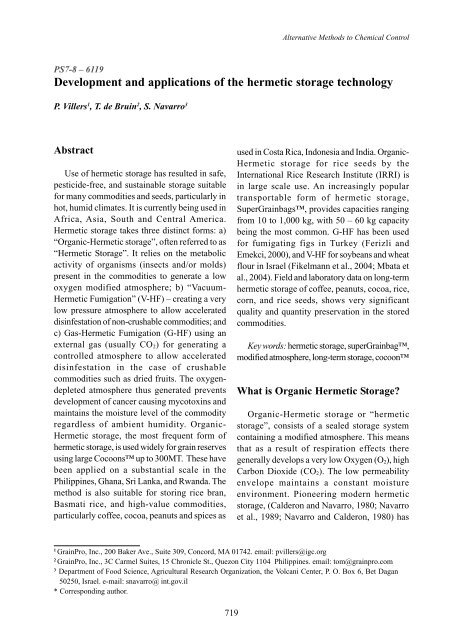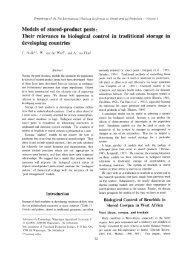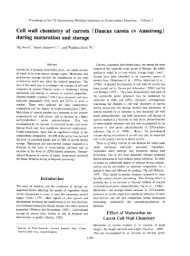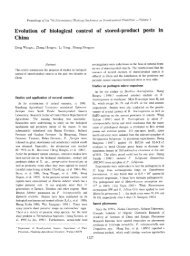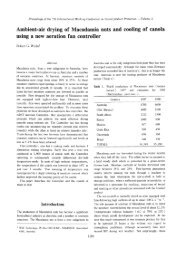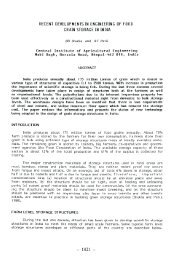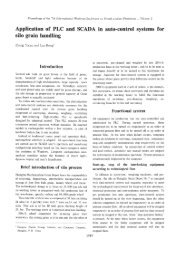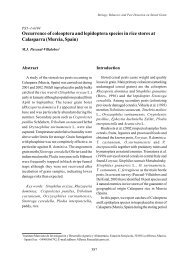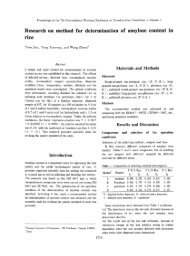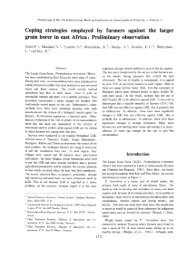Development and applications of the hermetic storage technology
Development and applications of the hermetic storage technology
Development and applications of the hermetic storage technology
You also want an ePaper? Increase the reach of your titles
YUMPU automatically turns print PDFs into web optimized ePapers that Google loves.
PS7-8 – 6119<br />
<strong>Development</strong> <strong>and</strong> <strong>applications</strong> <strong>of</strong> <strong>the</strong> <strong>hermetic</strong> <strong>storage</strong> <strong>technology</strong><br />
P. Villers 1 , T. de Bruin 2 , S. Navarro 3<br />
Abstract<br />
Use <strong>of</strong> <strong>hermetic</strong> <strong>storage</strong> has resulted in safe,<br />
pesticide-free, <strong>and</strong> sustainable <strong>storage</strong> suitable<br />
for many commodities <strong>and</strong> seeds, particularly in<br />
hot, humid climates. It is currently being used in<br />
Africa, Asia, South <strong>and</strong> Central America.<br />
Hermetic <strong>storage</strong> takes three distinct forms: a)<br />
“Organic-Hermetic <strong>storage</strong>”, <strong>of</strong>ten referred to as<br />
“Hermetic Storage”. It relies on <strong>the</strong> metabolic<br />
activity <strong>of</strong> organisms (insects <strong>and</strong>/or molds)<br />
present in <strong>the</strong> commodities to generate a low<br />
oxygen modified atmosphere; b) “Vacuum-<br />
Hermetic Fumigation” (V-HF) – creating a very<br />
low pressure atmosphere to allow accelerated<br />
disinfestation <strong>of</strong> non-crushable commodities; <strong>and</strong><br />
c) Gas-Hermetic Fumigation (G-HF) using an<br />
external gas (usually CO2) for generating a<br />
controlled atmosphere to allow accelerated<br />
disinfestation in <strong>the</strong> case <strong>of</strong> crushable<br />
commodities such as dried fruits. The oxygendepleted<br />
atmosphere thus generated prevents<br />
development <strong>of</strong> cancer causing mycotoxins <strong>and</strong><br />
maintains <strong>the</strong> moisture level <strong>of</strong> <strong>the</strong> commodity<br />
regardless <strong>of</strong> ambient humidity. Organic-<br />
Hermetic <strong>storage</strong>, <strong>the</strong> most frequent form <strong>of</strong><br />
<strong>hermetic</strong> <strong>storage</strong>, is used widely for grain reserves<br />
using large Cocoons up to 300MT. These have<br />
been applied on a substantial scale in <strong>the</strong><br />
Philippines, Ghana, Sri Lanka, <strong>and</strong> Rw<strong>and</strong>a. The<br />
method is also suitable for storing rice bran,<br />
Basmati rice, <strong>and</strong> high-value commodities,<br />
particularly c<strong>of</strong>fee, cocoa, peanuts <strong>and</strong> spices as<br />
used in Costa Rica, Indonesia <strong>and</strong> India. Organic-<br />
Hermetic <strong>storage</strong> for rice seeds by <strong>the</strong><br />
International Rice Research Institute (IRRI) is<br />
in large scale use. An increasingly popular<br />
transportable form <strong>of</strong> <strong>hermetic</strong> <strong>storage</strong>,<br />
SuperGrainbags, provides capacities ranging<br />
from 10 to 1,000 kg, with 50 – 60 kg capacity<br />
being <strong>the</strong> most common. G-HF has been used<br />
for fumigating figs in Turkey (Ferizli <strong>and</strong><br />
Emekci, 2000), <strong>and</strong> V-HF for soybeans <strong>and</strong> wheat<br />
flour in Israel (Fikelmann et al., 2004; Mbata et<br />
al., 2004). Field <strong>and</strong> laboratory data on long-term<br />
<strong>hermetic</strong> <strong>storage</strong> <strong>of</strong> c<strong>of</strong>fee, peanuts, cocoa, rice,<br />
corn, <strong>and</strong> rice seeds, shows very significant<br />
quality <strong>and</strong> quantity preservation in <strong>the</strong> stored<br />
commodities.<br />
Key words: <strong>hermetic</strong> <strong>storage</strong>, superGrainbag,<br />
modified atmosphere, long-term <strong>storage</strong>, cocoon<br />
What is Organic Hermetic Storage?<br />
Organic-Hermetic <strong>storage</strong> or “<strong>hermetic</strong><br />
<strong>storage</strong>”, consists <strong>of</strong> a sealed <strong>storage</strong> system<br />
containing a modified atmosphere. This means<br />
that as a result <strong>of</strong> respiration effects <strong>the</strong>re<br />
generally develops a very low Oxygen (O2), high<br />
Carbon Dioxide (CO2). The low permeability<br />
envelope maintains a constant moisture<br />
environment. Pioneering modern <strong>hermetic</strong><br />
<strong>storage</strong>, (Calderon <strong>and</strong> Navarro, 1980; Navarro<br />
et al., 1989; Navarro <strong>and</strong> Calderon, 1980) has<br />
1 GrainPro, Inc., 200 Baker Ave., Suite 309, Concord, MA 01742. email: pvillers@igc.org<br />
2 GrainPro, Inc., 3C Carmel Suites, 15 Chronicle St., Quezon City 1104 Philippines. email: tom@grainpro.com<br />
3 Department <strong>of</strong> Food Science, Agricultural Research Organization, <strong>the</strong> Volcani Center, P. O. Box 6, Bet Dagan<br />
50250, Israel. e-mail: snavarro@ int.gov.il<br />
* Corresponding author.<br />
719<br />
Alternative Methods to Chemical Control
9 th International Working Conference on Stored Product Protection<br />
resulted in <strong>the</strong> broad use <strong>of</strong> safe, pesticide-free<br />
<strong>hermetic</strong> <strong>storage</strong> suitable for many commodities<br />
<strong>and</strong> seeds, particularly in hot, humid climate.<br />
These <strong>hermetic</strong> <strong>storage</strong> systems as used primarily<br />
in Africa, Asia, South <strong>and</strong> Central America for a<br />
growing variety <strong>of</strong> both high <strong>and</strong> medium value<br />
commodities. Hermetic <strong>storage</strong> takes three<br />
distinct forms: a) “Organic-Hermetic <strong>storage</strong>”,<br />
relies on <strong>the</strong> metabolic activity <strong>and</strong> respiration<br />
<strong>of</strong> insects, micr<strong>of</strong>lora <strong>and</strong> <strong>the</strong> commodity itself<br />
to generate a modified, non-life sustaining low<br />
oxygen atmosphere; b) “Vacuum-Hermetic<br />
Fumigation” (V-HF) – uses a vacuum pump to<br />
rapidly create a very low pressure atmosphere<br />
for accelerated disinfestation <strong>of</strong> non-crushable<br />
commodities through asphyxiation; <strong>and</strong> c) Gas-<br />
Hermetic Fumigation (G-HF) uses an external<br />
gas source (usually CO2) for crushable<br />
commodities, such as dried fruit, prior to<br />
shipment. These methods (Figure 1), create a low<br />
oxygen modified atmosphere which normally<br />
results in 100 % insect mortality <strong>of</strong> al life stages<br />
in a few days to two weeks as well as preventing<br />
mold development, protecting quality <strong>and</strong><br />
preventing losses in <strong>the</strong> commodity. It also<br />
prevents development <strong>of</strong> cancer causing<br />
mycotoxins such as aflatoxins <strong>and</strong> ochratoxin A<br />
(OTA). The low permeability <strong>of</strong> <strong>the</strong> <strong>hermetic</strong><br />
structure also maintains safe constant moisture<br />
levels in previously dried commodities regardless<br />
<strong>of</strong> ambient exterior humidity.<br />
In some <strong>applications</strong>, such as for rice bran,<br />
brown rice, peanuts, <strong>and</strong> cocoa beans <strong>the</strong> quality<br />
loss due to increase <strong>of</strong> Free Fatty Acids (FFAs)<br />
are prevented through a low oxygen environment<br />
(De Bruin <strong>and</strong> Murali, 2006; Finkelmann et al.,<br />
2003; Montemayor, 2004). This is <strong>of</strong>ten a key<br />
consideration. Ano<strong>the</strong>r benefit is foregoing <strong>the</strong><br />
need for pesticides in post-harvest <strong>storage</strong>.<br />
As seen in Figures 5 <strong>and</strong> 8, <strong>hermetic</strong> <strong>storage</strong><br />
for grain reserves frequently uses large flexible<br />
plastic enclosures called Cocoons (also<br />
formerly called “Cubes” <strong>and</strong> “Volcani Cubes”)<br />
with a capacity up to 300 tonnes for ei<strong>the</strong>r indoor<br />
<strong>and</strong> outdoor <strong>storage</strong> in such places as Philippines,<br />
Ghana, Sri Lanka, <strong>and</strong> Rw<strong>and</strong>a (Villers, 2003;<br />
2006). The method is also suitable for long-term<br />
720<br />
<strong>storage</strong> <strong>of</strong> rice bran, Basmati rice, <strong>and</strong> such highvalue<br />
commodities as c<strong>of</strong>fee, cocoa, peanuts <strong>and</strong><br />
spices in addition to permitting long-term seed<br />
preservation without refrigeration (Van Chin,<br />
2005; Villers, 2006; US-ISTF, 2001).<br />
A more recent but increasingly popular<br />
transportable form <strong>of</strong> <strong>hermetic</strong> <strong>storage</strong>, called<br />
SuperGrainbags, as shown in Figure 2 from<br />
<strong>the</strong> International Rice Research Institute (IRRI)<br />
in <strong>the</strong> Philippines utilizes a thin, transparent,<br />
extremely low permeability co-extruded multi<br />
layer plastic as a liner to a conventional jute or<br />
polypropylene bag. SuperGrainbag capacities can<br />
range from 10 to 1,000 kg, with 43 – 60 kg<br />
capacity being <strong>the</strong> most common. At <strong>the</strong><br />
individual small farm level <strong>the</strong>y can be protected<br />
from rodents by <strong>storage</strong> in empty 55-gallon drums.<br />
Figure 1. Exposure time vs. CO2 levels with<br />
95 % mortality for Tribolium castaneum at 57 %<br />
r.h.
Figure 2. SuperGrainbag as a liner in a polybag<br />
container for rice seed at IRRI.<br />
721<br />
Alternative Methods to Chemical Control<br />
Micr<strong>of</strong>lora <strong>and</strong> critical moisture<br />
content<br />
Molds, yeasts, <strong>and</strong> bacteria make up what we<br />
call <strong>the</strong> “micr<strong>of</strong>lora” population. At an elevated<br />
humidity <strong>the</strong>y contribute significantly to <strong>the</strong><br />
respiration processes within <strong>the</strong> stored<br />
commodities. Most mold populations are<br />
“aerobic”, <strong>the</strong>y need oxygen for <strong>the</strong>ir<br />
development. Humidity requirements for rapid<br />
mold growth <strong>of</strong> aerobic micr<strong>of</strong>lora are within <strong>the</strong><br />
range <strong>of</strong> 65 % to 85 % r.h. (Figure 3).<br />
Ano<strong>the</strong>r term <strong>of</strong> importance is <strong>the</strong> “critical<br />
moisture content”, which is <strong>the</strong> level that a<br />
commodity’s moisture content will reach at a<br />
given temperature in equilibrium with 65 % r.h.<br />
(Figure 3). At higher levels <strong>of</strong> moisture content<br />
significant mold growth will take place except,<br />
importantly, when stored in a controlled<br />
atmosphere with low 02 <strong>and</strong> high CO2 levels.<br />
Figure 3. Critical moisture content vs. r.h. – various commodities (De Bruin, 2006).
9 th International Working Conference on Stored Product Protection<br />
As also seen in Figure 3, yeasts <strong>and</strong> bacteria<br />
require a higher humidity level to flourish.<br />
Why different types <strong>of</strong> <strong>hermetic</strong><br />
<strong>storage</strong>?<br />
The existence <strong>of</strong> three different types <strong>and</strong><br />
several different forms <strong>of</strong> <strong>hermetic</strong> <strong>storage</strong> has<br />
to do with meeting different post-harvest <strong>storage</strong><br />
<strong>and</strong> transportation needs. The most widely used<br />
form <strong>of</strong> <strong>hermetic</strong> <strong>storage</strong> is Organic-Hermetic<br />
<strong>storage</strong>. These systems are used for medium to<br />
long-term <strong>storage</strong> <strong>of</strong> conventional grain bags <strong>and</strong><br />
are commercially available in 5 tonne to 300<br />
tonnes capacity. They are used for farm, village,<br />
district level, or commercial <strong>storage</strong> <strong>of</strong> bagged<br />
grains or seeds <strong>of</strong> many different types for periods<br />
ranging from a month to, in some cases, several<br />
years. The commodities range widely in value<br />
from such high volume grains as sorghum, wheat,<br />
pulses, corn <strong>and</strong> rice to expensive commodities<br />
such as spices, cocoa, c<strong>of</strong>fee <strong>and</strong> various hybrid<br />
seeds.<br />
A fur<strong>the</strong>r distinction in <strong>hermetic</strong> <strong>storage</strong> types<br />
has to do with transportability. Most <strong>hermetic</strong><br />
<strong>storage</strong> systems made from flexible food grade<br />
PVC such as those in Figures 5 <strong>and</strong> 8 are lightweight<br />
<strong>and</strong> portable when empty, but not portable<br />
when full. With <strong>the</strong> introduction in 2001 <strong>of</strong><br />
SuperGrainbags as seen in Figure 4, <strong>hermetic</strong><br />
Figure 4. SuperGrainbags, paddy seed,<br />
Philippines.<br />
722<br />
<strong>storage</strong> became possible during transport <strong>and</strong><br />
subsequent distribution. Major <strong>applications</strong> at<br />
present are for a variety <strong>of</strong> seeds, c<strong>of</strong>fee <strong>and</strong> cocoa<br />
beans.<br />
Why <strong>hermetic</strong> <strong>storage</strong> for seeds?<br />
The principal reasons for using <strong>hermetic</strong><br />
<strong>storage</strong> for seeds is to prevent fur<strong>the</strong>r insect<br />
development, by creating a low oxygen, high CO2<br />
atmosphere lethal to insects already present<br />
inside <strong>the</strong> container. It is also used to prevent<br />
rodent penetration during <strong>storage</strong>, <strong>and</strong> prevent<br />
<strong>the</strong> growth <strong>of</strong> molds as well as deterioration <strong>of</strong><br />
<strong>the</strong> commodity by protecting it from <strong>the</strong> high<br />
outside relative humidity levels that prevail in<br />
hot humid climates. In <strong>the</strong> case <strong>of</strong> seeds,<br />
maintaining seed germination percentage <strong>and</strong><br />
vigor is <strong>the</strong> dominant consideration (De Bruin,<br />
2005).<br />
Hermetic <strong>storage</strong> for seeds – in<br />
practice<br />
Starting in <strong>the</strong> 1990s work on <strong>the</strong> application<br />
<strong>of</strong> <strong>hermetic</strong> <strong>storage</strong> <strong>of</strong> seeds, focusing especially<br />
on rice seeds, was carried out by <strong>the</strong> International<br />
Rice Research Institute (IRRI) in <strong>the</strong><br />
Philippines (Rickmann <strong>and</strong> Aquino, 2003;<br />
2004). This led to <strong>the</strong> increasingly widespread<br />
use for seed <strong>storage</strong>, not only <strong>of</strong> <strong>the</strong> large flexible<br />
<strong>hermetic</strong> <strong>storage</strong> known as “Cocoons”, shown<br />
storing maize seeds in Thail<strong>and</strong>, Figure 5 but<br />
more recently to storing seed in man portable<br />
<strong>hermetic</strong> <strong>storage</strong> called SuperGrainbags used<br />
as liners to conventional bags in <strong>the</strong> 50-60 kg<br />
range such as seen in Figures 2 & 4. In turn, this<br />
latter form has <strong>the</strong> benefit <strong>of</strong> allowing <strong>hermetic</strong><br />
<strong>storage</strong> during <strong>the</strong> transportation <strong>and</strong> distribution<br />
phase where o<strong>the</strong>rwise previously safely stored<br />
seed might degrade. The <strong>hermetic</strong> technique for<br />
maintaining seeds, as also shown in Table 1 from<br />
IRRI, has equivalent results to more expensive<br />
refrigeration processes in maintaining a high<br />
level <strong>of</strong> germination <strong>and</strong> vigor. As seen in Table
2, results for <strong>hermetic</strong> <strong>storage</strong> <strong>of</strong> seeds show large<br />
differences over conventional unrefrigerated<br />
bagged <strong>storage</strong> in retention <strong>of</strong> germination <strong>and</strong><br />
vigor when stored in hot humid climates (De<br />
Bruin, 2005).<br />
Gas-Hermetic Fumigation (G-HF):<br />
Hermetic <strong>storage</strong> for disinfestation <strong>of</strong><br />
dried fruit<br />
G-HF <strong>hermetic</strong> <strong>storage</strong> is used for dried fruit<br />
such as for figs in Turkey, for rapid pesticidefree<br />
“fumigation” before shipment, using bottled<br />
CO2, as shown in Figure 6. This modified<br />
atmosphere at room temperature causes complete<br />
Figure 5. Cocoon, 10 MT <strong>of</strong> seed, Uniseed,<br />
Thail<strong>and</strong><br />
723<br />
Alternative Methods to Chemical Control<br />
kill <strong>of</strong> all life stages <strong>of</strong> such pests as <strong>the</strong> tropical<br />
warehouse moth (Ephestia cautella), a major pest<br />
<strong>of</strong> dried figs, within 5 days or less. A different<br />
version called a PITS Tunnel, is suspended<br />
from a light frame <strong>and</strong> is especially designed for<br />
more rapid loading/unloading.<br />
Storage <strong>of</strong> rice <strong>and</strong> rice products<br />
Asia has become <strong>the</strong> largest user <strong>of</strong> <strong>hermetic</strong><br />
<strong>storage</strong> principally because <strong>of</strong> its use for safe<br />
<strong>storage</strong> <strong>of</strong> rice seeds <strong>and</strong> rice products. Rice<br />
stored in hot humid climates not only has a high<br />
degree <strong>of</strong> insect infestation <strong>and</strong> problems with<br />
rodents, but also has issues with quality: normally<br />
taste <strong>and</strong> appearance deteriorates significantly in<br />
<strong>storage</strong> – typically after about 6 months. Milled<br />
rice, which is more difficult to store, takes 20 %<br />
less <strong>storage</strong> space than paddy (un-milled rice).<br />
Experiments in <strong>the</strong> Philippines at IRRI have<br />
shown that when milled rice is stored<br />
<strong>hermetic</strong>ally, it can be safely kept for more than<br />
one year (Rickman <strong>and</strong> Aquino, 2003; 2004).<br />
In <strong>the</strong> case <strong>of</strong> rice bran <strong>and</strong> brown rice low<br />
oxygen levels occur very rapidly due to <strong>the</strong><br />
commodity’s respiration, typically to below 1%<br />
oxygen (Montemayor, 2004), allowing safe<br />
<strong>storage</strong> for periods <strong>of</strong> time o<strong>the</strong>rwise not possible.<br />
Figure. 6. Dried figs (left), G-HF Cocoons in Turkey (right) (Ferizli <strong>and</strong> Emekci, 2000).
9 th International Working Conference on Stored Product Protection<br />
Table 1. Live insects per 500 gm <strong>of</strong> grain for 12 month <strong>storage</strong>, Philippines, 2002.<br />
Month Cocoons Open Air Cold 251 plastic Aluminium<br />
0 4.4 1.6 4.2 4.2 3.7 5<br />
3 0.0 117.6 0.8 0.0 0.7 1.0<br />
6 0.2 57.2 1.5 0.0 0.8 1.8<br />
9 0.2 27.2 1.7 0.0 0.6 0.6<br />
12 1.1 13.6 4.5 0.0 0.6 0.1<br />
Table 2. Maize (corn) <strong>and</strong> Paddy trials. Seed <strong>storage</strong> <strong>of</strong> various commodities, <strong>hermetic</strong> vc non-<strong>hermetic</strong><br />
<strong>storage</strong>.<br />
Seed Storage Length Initial Germina- Moisture Moisture Insect Insect<br />
<strong>storage</strong> condition <strong>of</strong> trial germina- tion content content infestation infestation<br />
(days) tion potential (%) at (%) at life insects/kg life insects/kg<br />
% at end <strong>of</strong> start <strong>of</strong> end <strong>of</strong> at start <strong>of</strong> at end <strong>of</strong><br />
trial (%) trial trial trial trial<br />
Mexico 1<br />
(maize) <strong>hermetic</strong> 3 97 95 14.5 14.3<br />
non-<strong>hermetic</strong> 3 97 97 14.5 14.2<br />
<strong>hermetic</strong> 6 97 78 14.5 14.2<br />
non-<strong>hermetic</strong> 6 97 74 14.5 14.0<br />
<strong>hermetic</strong> 3 96 76 16.6 17.6<br />
non-<strong>hermetic</strong> 3 96 19 16.6 16.5<br />
<strong>hermetic</strong> 4 96 44 16.6 17.6<br />
non-<strong>hermetic</strong> 4 96 14 16.6 16.5<br />
Thail<strong>and</strong> 2 <strong>hermetic</strong> 90 97.21 98.2 12.4 12.2 2 0<br />
Outdoor non-<strong>hermetic</strong> 90 97.21 95 12.4 11.5 0 27<br />
Thail<strong>and</strong> <strong>hermetic</strong> 280 97.21 81.21 12.2 13.6 0 27<br />
Outdoor non-<strong>hermetic</strong> 280 97.21 0 12.2 0 100<br />
(paddy)<br />
Bangladesh 3 <strong>hermetic</strong> 120 87 10 11 - -<br />
(paddy) non-<strong>hermetic</strong> 120 9<br />
Bangladesh 4 <strong>hermetic</strong> 100 98 95 13.1 12.7 85 1<br />
(paddy) non-<strong>hermetic</strong> 98.3 74 13.2 12.8 74 77<br />
<strong>hermetic</strong> 210 98 90 13.1 13 85 12<br />
non-<strong>hermetic</strong> 98.3 1 13.2 13.5 74 47<br />
Combodia 5 <strong>hermetic</strong> 223 97 91 13 13.6 13.7 0<br />
(paddy) non-<strong>hermetic</strong> 95 66 13.1 14.8 32.3 25.8<br />
1 See Moreno et al. (1988).<br />
2 See Minagri (2006).<br />
3 Data supplied by Allied Agro Industries, Dhaka.<br />
4 Testing <strong>of</strong> <strong>the</strong> GrainPro Cocoon for <strong>storage</strong> pf Paddy in BRRI, prepared by M. Aul Quasen, SSO, FMPHT Div. <strong>and</strong><br />
A. Abdur Rahman, SSO, FMPHT Div. Gazipur - 2001.<br />
5 Data collected by Som Bunna, Agricultural Engineer at CARDI, Phnom Penh, dated 15 Mar 2001.<br />
724
Bulk <strong>applications</strong> <strong>of</strong> organic<br />
<strong>hermetic</strong> <strong>storage</strong><br />
Today <strong>hermetic</strong> <strong>storage</strong> <strong>of</strong> maize <strong>and</strong> wheat<br />
is used on a large scale in several countries. For<br />
instance in Rw<strong>and</strong>a a total <strong>of</strong> several hundred<br />
50 tonnes to 225 tonnes capacity Cocoons, such<br />
as those seen in Figures 7 <strong>and</strong> 8, are now used.<br />
Cocoons are used <strong>the</strong>re for long-term <strong>storage</strong> <strong>of</strong><br />
corn, sorghum, <strong>and</strong> beans. In a Rw<strong>and</strong>an Ministry<br />
<strong>of</strong> Agriculture (“Minagri”) report (Minagri, 2006)<br />
<strong>the</strong>y conclude (as translated) “... after more than<br />
30 months <strong>of</strong> <strong>storage</strong> in some units, we observed<br />
<strong>the</strong> following:<br />
The insects present in <strong>the</strong> grains during<br />
725<br />
Alternative Methods to Chemical Control<br />
initial <strong>storage</strong> were all dead <strong>and</strong> no reinfestation<br />
was recorded.<br />
In most cases <strong>the</strong> grains remained identical<br />
in appearance <strong>and</strong> preserved <strong>the</strong>ir germination<br />
potential.<br />
They estimate losses under conventional<br />
<strong>storage</strong> as 12.5-25 % over 12 months. A USAID<br />
sponsored study (Usaid, 1996) showed that wheat<br />
could be preserved with excellent results in<br />
flexible <strong>hermetic</strong> <strong>storage</strong> systems for periods <strong>of</strong><br />
up to five years. Figure 8 shows a 150 tonnes<br />
Cocoon toge<strong>the</strong>r with its GrainShade used<br />
outdoors in <strong>the</strong> Philippines for storing rice paddy<br />
by <strong>the</strong> National Food Authority (NFA).<br />
Figure 7. C<strong>of</strong>fee, Monte D’Oro Cooperative, Costa Rica.<br />
Figure 8. 150 MT Cocoon with GrainShade, Philippines.
9 th International Working Conference on Stored Product Protection<br />
Storage <strong>of</strong> premium c<strong>of</strong>fee <strong>and</strong> <strong>of</strong><br />
shelled Peanuts<br />
Only in <strong>the</strong> last few years have <strong>the</strong> benefits <strong>of</strong><br />
<strong>hermetic</strong> <strong>storage</strong> been fully appreciated in<br />
maintaining <strong>the</strong> quality – aroma <strong>and</strong> taste, as<br />
determined by cupping tests, as well as<br />
appearance <strong>of</strong> c<strong>of</strong>fee stored in hot humid climate.<br />
In Costa Rica for instance, <strong>the</strong> c<strong>of</strong>fee crop is<br />
harvested from October through February. This<br />
c<strong>of</strong>fee is <strong>the</strong>n consumed or exported from March<br />
onward. Therefore, <strong>the</strong> need for long-term<br />
<strong>storage</strong>, which preserves <strong>the</strong> quality <strong>of</strong> premium<br />
c<strong>of</strong>fee beans, is critical. The first large<br />
commercial user <strong>of</strong> <strong>hermetic</strong> <strong>storage</strong> for c<strong>of</strong>fee<br />
was Café Britt in Costa Rica.<br />
According to <strong>the</strong>ir pr<strong>of</strong>essional cupper, after<br />
<strong>storage</strong> <strong>of</strong> five months: “The (cup average)<br />
Figure 9. Equilibrium moisture content (EMC)<br />
<strong>of</strong> c<strong>of</strong>fee beans vs. r.h. under equilibrium<br />
conditions at 28 °C.<br />
726<br />
quality remained at 4.0 (5 point scale) for those in<br />
<strong>the</strong> Cocoon <strong>and</strong> dropped to 3.0 for unprotected<br />
c<strong>of</strong>fee beans. The superiority <strong>of</strong> c<strong>of</strong>fee stored in<br />
<strong>hermetic</strong> Cocoons became very noticeable”<br />
(Figure 9).<br />
Recently <strong>the</strong> use <strong>of</strong> <strong>hermetic</strong> <strong>storage</strong> has been<br />
extended to <strong>the</strong> <strong>storage</strong> <strong>of</strong> peanuts where <strong>the</strong><br />
increase <strong>of</strong> FFA (Free Fatty Acids), <strong>and</strong> mold<br />
development may result in production <strong>of</strong> cancercausing<br />
aflatoxins, <strong>and</strong> can cause entire<br />
shipments to be rejected. Studies done in Vietnam<br />
found, as seen in Figure 10, that <strong>hermetic</strong> <strong>storage</strong><br />
<strong>of</strong> unshelled peanut seeds for 8 months in<br />
SuperGrainbags maintains constant moisture <strong>and</strong><br />
germination rates virtually identical with <strong>the</strong><br />
costly refrigerated <strong>storage</strong> while in unprotected<br />
<strong>storage</strong>. The germination rate dropped to 3% (Van<br />
Chin, 2005). As seen in Table 2, similar results<br />
have been observed for rice seed.<br />
Storage <strong>of</strong> cocoa – special<br />
considerations<br />
Particularly problematic in cocoa bean <strong>storage</strong><br />
is <strong>the</strong> deleterious effects <strong>of</strong> molds, micr<strong>of</strong>lora,<br />
<strong>and</strong> oxidation. Oxidation leads to <strong>the</strong> increase <strong>of</strong><br />
free fatty acids (FFAs), which have a negative<br />
impact on <strong>the</strong> quality <strong>of</strong> cocoa. With <strong>hermetic</strong><br />
Figure 10. Peanut seed <strong>storage</strong> germination vs.<br />
time.
<strong>storage</strong> <strong>of</strong> cocoa, as seen in Figure 11, oxygen levels<br />
typically go down to 2 % or less in a week,<br />
protecting <strong>the</strong> commodity against insects,<br />
oxidations effects, <strong>and</strong> <strong>the</strong> growth <strong>of</strong> molds (De<br />
Bruin <strong>and</strong> Murali, 2006).<br />
Figure 11. Changes in modified atmosphere, cocoa<br />
beans, 73.2 % ERH (De Bruin, 2006).<br />
Alternatives to <strong>hermetic</strong> <strong>storage</strong><br />
Alternatives to <strong>hermetic</strong> <strong>storage</strong> <strong>and</strong> modified<br />
atmosphere include use <strong>of</strong> fumigants,<br />
refrigeration, freezing, <strong>and</strong> conventional<br />
unprotected <strong>storage</strong>. With fumigants full<br />
penetration <strong>of</strong> <strong>the</strong> commodity is <strong>of</strong>ten a problem,<br />
repeated <strong>applications</strong> are frequently necessary<br />
<strong>and</strong> fumigants do not prevent losses from rodents<br />
or <strong>the</strong> growth <strong>of</strong> molds. In addition insects have<br />
developed tolerance to widely used fumigants<br />
<strong>and</strong> <strong>the</strong> most popular fumigant, Methyl Bromide<br />
is being phased out. Refrigeration, in <strong>the</strong> case <strong>of</strong><br />
seeds, remains widely used, but consumes<br />
significant energy, <strong>and</strong> requires special facilities.<br />
Freezing, ano<strong>the</strong>r expensive process, has also<br />
been used. Most <strong>of</strong> <strong>the</strong> world still uses<br />
conventional <strong>storage</strong>, such as <strong>storage</strong> <strong>of</strong> bagged<br />
grains under large tin ro<strong>of</strong>s in open warehouses.<br />
This provides no protection from rodents, limited<br />
protection by spraying against insects, <strong>and</strong> no<br />
meaningful steps to prevent mold growth. In hot<br />
humid climates losses are frequently <strong>of</strong> 12.5 to<br />
25 %. (Minagri, 2006).<br />
Hermetic <strong>storage</strong> as compared to older <strong>storage</strong><br />
727<br />
Alternative Methods to Chemical Control<br />
processes is still relatively new, <strong>and</strong> not as well<br />
known, but its use in some 20 countries <strong>and</strong> its<br />
increasing acceptance in particular niche markets<br />
where <strong>the</strong> need for better <strong>storage</strong> techniques is<br />
urgent, is causing rapid growth. Particularly<br />
noteworthy in this respect are <strong>applications</strong> for<br />
seeds, cocoa, c<strong>of</strong>fee, rice (including basmati rice,<br />
brown rice <strong>and</strong> rice bran) as well as large stores<br />
<strong>of</strong> staple grains.<br />
Future Applications<br />
Among promising new large-scale<br />
<strong>applications</strong> are those with high moisture corn<br />
(30 %) used for ethanol production <strong>and</strong> for <strong>the</strong><br />
starch industry – both use large amounts <strong>of</strong> dry<br />
corn <strong>and</strong> <strong>the</strong>n re-moisturize before processing.<br />
Ethanol produced from corn is a fast growing<br />
industry due to <strong>the</strong> increased energy prices<br />
worldwide.<br />
In <strong>the</strong> U.S. high moisture corn is already being<br />
used for feeding cattle. In China high moisture<br />
corn is being used for ethanol production during<br />
<strong>the</strong> cold winter months.<br />
Conclusion<br />
Almost 25 years after modern <strong>hermetic</strong><br />
<strong>storage</strong> systems were first developed, <strong>the</strong> use <strong>of</strong><br />
<strong>hermetic</strong> <strong>storage</strong> is now becoming widespread<br />
using modern low permeability plastic materials<br />
which are light-weight, can be used indoors or<br />
outdoors, have long lives (10-15 years in <strong>the</strong> case<br />
<strong>of</strong> Cocoons) <strong>and</strong> are now, in <strong>the</strong> case <strong>of</strong><br />
SuperGrainbags, transportable when full.<br />
Pesticide-free Hermetic <strong>storage</strong> <strong>technology</strong> has<br />
already been found suitable for a number <strong>of</strong><br />
markets. This is especially true where<br />
conventional <strong>storage</strong>, such as in hot humid<br />
climates, fails to adequately protect <strong>the</strong> stored<br />
commodity for <strong>the</strong> desired time <strong>and</strong> this results<br />
in large losses in quantity <strong>and</strong> quality (Villers,<br />
2006).<br />
Hermetic <strong>storage</strong> is sustainable; it is userfriendly<br />
<strong>and</strong> an environmentally benign
9 th International Working Conference on Stored Product Protection<br />
<strong>technology</strong> that does not necessitate <strong>the</strong> use <strong>of</strong><br />
chemical pesticides. The <strong>technology</strong> can be<br />
adapted to <strong>the</strong> protection <strong>of</strong> commodities in sizes<br />
ranging from that <strong>of</strong> conventional grain bag size<br />
to many thous<strong>and</strong>s <strong>of</strong> tonnes.<br />
References<br />
Calderon, M., Navarro, S., 1980. Synergistic<br />
effect <strong>of</strong> CO2 <strong>and</strong> O2 mixture on stored<br />
grain insects. Pages 79-84. In: Controlled<br />
Atmosphere Storage <strong>of</strong> Grains. J. Shejbal,<br />
Ed. Elsevier, Amsterdam.<br />
De Bruin, T., 2006. A User’s Introduction to<br />
Hermetic Storage – How it Works.<br />
(unpublished). GrainPro Document<br />
Number SL2322TDB0506-4. GrainPro,<br />
Inc. Concord, MA USA.<br />
De Bruin, T., Murali, V., 2006. Quality<br />
Preservation <strong>of</strong> Stored Cocoa Beans in <strong>the</strong><br />
Tropics. (unpublished). GrainPro<br />
Document Number SL2299TB0905.<br />
GrainPro, Inc. Concord, MA USA.<br />
De Bruin, T., 2005. Seeds in Store… Asian<br />
Seed & Planting Material, February, 2005.<br />
Ferizli, A.G., Emekci, M., 2000. Carbon<br />
dioxide fumigation as a methyl bromide<br />
alternative for <strong>the</strong> dried fig industry, In: G.<br />
L. Obenauf <strong>and</strong> R. Obenauf (Eds), Annual<br />
International Research Conference on<br />
Methyl Bromide Alternatives <strong>and</strong><br />
Emissions Reductions, Orl<strong>and</strong>o, Florida,<br />
pp. 81.<br />
Finkelman, S., Navarro, S., Rindner, M., Dias,<br />
R., 2004. Transportable Hermetic Storage<br />
<strong>and</strong> Vacuum Equipment for Disinfestation<br />
<strong>of</strong> Durable Commodities. International<br />
Conference on Methyl Bromide<br />
Alternatives. Lisbon, Portugal.<br />
Finkelman, S., Navarro, S., Isikber, A., Dias,<br />
728<br />
R., Azrieli, A., Rindner, M., Lotan, Y., De<br />
Bruin, T., 2003. Insects control <strong>of</strong> cocoa<br />
pests using a novel vacuum approach.<br />
IWCSPP, CAB International, Oxon, UK,<br />
pp. 579-582.<br />
Mbata, George N., Phillips, T.W., Payton, M.,<br />
2004. Mortality <strong>of</strong> Eggs <strong>of</strong> Stored-Product<br />
Insects Held Under Vacuum: Effects <strong>of</strong><br />
Pressure, Temperature, <strong>and</strong> Exposure Time.<br />
Journal <strong>of</strong> Economic Entomology 97, 1.<br />
Montemayor, R., 2004. Better Rice in Store.<br />
World Grain, November, 2004.<br />
Moreno, E., Benavides, C., Ramirez, J., 1988.<br />
“The Influence <strong>of</strong> Hermetic Storage on <strong>the</strong><br />
Behaviour <strong>of</strong> Maize Seed Germination”. Seed<br />
Science <strong>and</strong> Technology 16, 427-434.<br />
Navarro, S., Donahaye, E., Dias, R., Jay, E.,<br />
1989. Integration <strong>of</strong> modified atmospheres<br />
for disinfestation <strong>of</strong> dried fruits. Final<br />
Scientific Report <strong>of</strong> Project No: I-1095-86,<br />
submitted to US-Israel Bi-national<br />
Agricultural Research <strong>and</strong> <strong>Development</strong><br />
Fund (BARD) 86 pp.<br />
Navarro, S., Calderon, M., 1980. Integrated<br />
approach to <strong>the</strong> use <strong>of</strong> controlled<br />
atmospheres for insect control in grain<br />
<strong>storage</strong>. Pages 73-78. in: Controlled<br />
Atmosphere Storage <strong>of</strong> Grains. J. Shejbal,<br />
Ed. Elsevier, Amsterdam.<br />
Rickman, J.F., Aquino, E., 2003. Hermetically<br />
Sealed Grain Storage Systems. (unpublished),<br />
IRRI, Philippines, GrainPro Document<br />
Number SL2258PV0803, GrainPro, Inc.<br />
Concord, MA USA.<br />
Rickman, J.F., Aquino, E., 2004. Appropriate<br />
Technology for Maintaining Grain Quality in<br />
Small-scale Storages. CAF2004 International<br />
Conference on Controlled Fumigation in<br />
Stored Products 8-13 August 2004 Gold<br />
Coast, Australia.
Minagri (Rw<strong>and</strong>an Ministry <strong>of</strong> Agriculture), 2006.<br />
Systeme de Stockage Hermetique au<br />
Rw<strong>and</strong>a: 36 mois d’experience. Minagri.<br />
Kigali, Rw<strong>and</strong>a.<br />
Van Chin, D., 2005. Primary Results <strong>of</strong><br />
Hermetically Sealed Grain Storage Systems at<br />
Cuulong Delta Rice Research Institute.<br />
(unpublished). GrainPro, Document<br />
Number SL2310TB1205, GrainPro, Inc.<br />
Concord, MA USA.<br />
Villers, P., 2003. Cocoons Dramatically<br />
Reduce Pests in Store. Integrated Pest<br />
Management 29, 3.<br />
729<br />
Alternative Methods to Chemical Control<br />
Villers, P., 2006. Safe Storage <strong>of</strong> Grain in <strong>the</strong><br />
Tropics. Feed Technology Update 1, 3.<br />
US-ISTF (United States–Israel Science <strong>and</strong><br />
Technology Foundation), 2001. <strong>Development</strong><br />
<strong>of</strong> Alternative Fumigation Systems <strong>and</strong><br />
Methods to Reduce Methyl Bromide Emission<br />
in Post-Harvest Treatments. USISTF Final<br />
Report, 2001.<br />
Usaid, 1996. Application <strong>of</strong> Modified<br />
Atmospheres Under Plastic Covers for<br />
Prevention <strong>of</strong> Losses in Stored Grain. In:<br />
Navarro, S. Report. U.S. Agency for<br />
International <strong>Development</strong>, Philippines.


